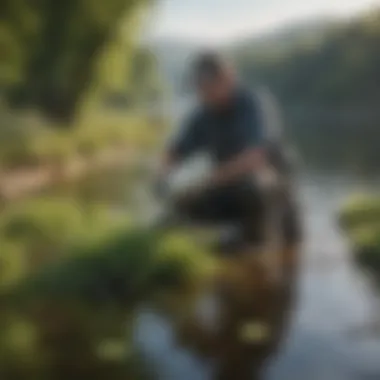Mastering Lake Weed Control: A Detailed Guide on Chemical Management


Overview of the Topic
Lake weeds present a significant environmental challenge, impacting the ecological balance of freshwater bodies. These aquatic plants can rapidly colonize lakes, leading to reduced water quality, biodiversity loss, and hindered recreational activities. The uncontrolled growth of lake weeds also poses a threat to native species and disrupts the natural habitat of aquatic organisms. Understanding the dynamics of lake weed proliferation and implementing effective management strategies are crucial for the preservation of aquatic ecosystems.
Current Status and Challenges
The current state of lake weed infestation is a pressing concern for environmentalists and conservationists. Factors such as nutrient runoff, climate change, and human activities contribute to the proliferation of invasive aquatic plants in lakes. Traditional weed control methods like manual removal and mechanical harvesting are often inadequate in addressing large-scale infestations. Additionally, the limited availability of environmentally-friendly alternatives further complicates the management of lake weeds, posing challenges to sustainable control efforts.
Sustainable Solutions
To combat the challenges associated with managing lake weeds, adopting sustainable practices is paramount. Integrated weed management approaches, including the use of chemical herbicides, biological controls, and physical barriers, offer promising strategies for controlling invasive plant species while minimizing environmental impact. Implementing eco-friendly herbicide formulations, promoting native aquatic vegetation, and establishing buffer zones around water bodies are essential components of sustainable lake weed management. Successful case studies demonstrate the effectiveness of these holistic approaches in achieving long-term weed control and promoting ecosystem resilience.
Impact and Importance
The impact of unchecked lake weed growth extends beyond the aquatic environment, affecting both terrestrial and aquatic ecosystems. Excessive weed proliferation can lead to oxygen depletion, habitat degradation, and altered nutrient cycles, disrupting the balance of entire ecosystems. Conservation efforts aimed at mitigating the adverse effects of lake weeds are crucial for preserving biodiversity, improving water quality, and safeguarding the ecological stability of freshwater ecosystems. Emphasizing the importance of sustainable resource management and community engagement is essential in fostering a harmonious relationship between humans and nature, ensuring the long-term health and vitality of our natural surroundings.
Introduction to Managing Lake Weeds with Chemicals
In this article, we delve into the intricate world of managing lake weeds through the use of chemicals. Lake weeds pose a significant challenge to aquatic ecosystems, and understanding how to effectively control them is crucial. Chemical treatment is one of the methods used for weed control, offering both advantages and risks that need to be carefully considered for sustainable management.
Understanding the Impact of Lake Weeds


- The Ecological Importance of Aquatic Plants: Aquatic plants play a vital role in maintaining the health of lake ecosystems. They provide oxygen, shelter, and food for various aquatic organisms, contributing to biodiversity. However, when lake weeds overgrow, they can outcompete native species, disrupting the balance of the ecosystem.
- Challenges Posed by Overgrowth of Lake Weeds: Overgrowth of lake weeds can lead to several challenges, including decreased water quality, reduced oxygen levels, and habitat degradation. Managing this overgrowth is essential to prevent further ecological imbalances and ensure the sustainability of the lake ecosystem.
Benefits and Risks of Chemical Weed Control
- Advantages of Chemical Weed Control: Chemical weed control offers an efficient and targeted solution to managing lake weeds. It can effectively reduce weed populations, restoring ecosystem balance. Additionally, chemical treatment can be applied with precision, minimizing impact on non-target species when used correctly.
- Potential Environmental Concerns: Despite its benefits, chemical weed control raises environmental concerns. Runoff from herbicides and algaecides can affect non-target species and water quality. Careful consideration of application methods and dosages is essential to mitigate these risks and ensure eco-friendly weed management.
Types of Chemicals Used for Lake Weed Control
In the realm of effectively managing lake weeds, understanding the various types of chemicals used holds significant importance. The utilization of chemicals plays a crucial role in controlling and eradicating unwanted weed growth in aquatic environments. By exploring different types of chemicals, such as herbicides and algaecides, individuals can develop tailored strategies to combat specific weed species effectively. Moreover, comprehending the characteristics, benefits, and considerations associated with these chemicals is essential for success in weed control endeavors.
Herbicides
Herbicides, a fundamental component of weed control, can be categorized into contact herbicides and systemic herbicides. Contact herbicides, as the name suggests, act upon direct contact with the weed's foliage, disrupting its growth and eventually leading to its decline. This form of herbicide is advantageous for targeting specific weed-infested areas without affecting surrounding vegetation excessively. However, one must be mindful of its quick but surface-level impact, necessitating multiple applications for sustained control.
On the other hand, systemic herbicides are absorbed by the weed and translocated throughout its system, delivering a thorough and widespread effect. This method proves advantageous for targeting extensive weed populations or hard-to-reach areas. Yet, its systemic nature also poses challenges as it can affect non-target plants if not applied with precision.
Algaecides
Algaecides are another category of chemicals vital for managing aquatic environments plagued by algae overgrowth. Within this category, copper-based algaecides offer an effective solution by disrupting algae cell membranes, leading to their decomposition. Their popularity stems from the rapid and visible results they provide in curbing algae blooms. However, excessive use of copper-based algaecides can accumulate in the water and have potential long-term ecological impacts.
Contrastingly, peroxide-based algaecides work by releasing oxygen atoms upon contact with water, which oxidize and erode algae cells. This method offers a safer and eco-friendly approach to algae control, with minimal residual effects. Despite their efficacy, the higher cost associated with peroxide-based algaecides may influence their widespread application.


Mechanism of Action of Chemicals
Understanding the mechanisms through which these chemicals operate is crucial for optimizing their efficacy in weed control. Disruption of photosynthesis, a common mechanism employed by many herbicides and algaecides, inhibits the weed or algae's ability to produce energy, ultimately leading to their demise. This approach is effective in rapidly reducing weed and algae populations but requires careful consideration to minimize harm to non-target species.
Inhibition of cell growth, another prevalent mechanism utilized in weed control, targets the cellular division processes of weeds and algae, impeding their reproduction and growth. While this method offers a targeted approach to population control, repeated use may lead to the development of resistant weed or algae strains.
Environmental Considerations in Chemical Weed Control
In the realm of managing lake weeds with chemicals, one overarching aspect that demands meticulous attention is environmental considerations. These considerations, pivotal to the holistic approach of weed control, encompass a spectrum of key factors vital in preserving the delicate balance of aquatic ecosystems. Not merely a secondary concern, but rather an integral component, environmental considerations dictate the course of actions undertaken in chemical weed control. By meticulously evaluating the potential impacts of chemicals on the surrounding environment, one can aspire towards sustainable and effective weed management. Environmental considerations in chemical weed control play a fundamental role in the seamless integration of human interventions with the natural world.
Impact on Non-Target Species
Mitigating Harm to Beneficial Aquatic Life
Mitigating harm to beneficial aquatic life surfaces as a paramount objective in chemical weed control strategies. This indispensable facet emphasizes the imperative need to safeguard and nurture the diverse array of aquatic organisms flourishing within lake ecosystems. By employing targeted approaches that minimize collateral damage to non-target species, stakeholders can uphold the intricate ecological balance thriving beneath the water's surface. The bespoke methodology of mitigating harm to beneficial aquatic life underscores a conscientious stance towards preserving the foundation of aquatic biodiversity. Its tailored focus on ecological symbiosis and interdependence distinguishes it as a judicious choice within the overarching narrative of effective lake weed management.
Minimizing Residue in Water Bodies
Minimizing residue in water bodies represents a pivotal directive within the realm of chemical weed control. This particular directive delves into the meticulous mitigation of chemical remnants post-application, advocating for pristine water quality within lake environments. By ameliorating the presence of residual chemicals, this approach exemplifies a dedication to enhancing the overall ecological integrity of aquatic systems. The nuanced emphasis on minimizing residue underscores a conscientious approach towards fostering a sustainable milieu where water bodies retain their innate purity. Its scrupulous endeavor to minimize chemical traces accentuates a profound commitment to the long-term preservation of water ecosystems.
Regulatory Guidelines and Compliance


The adherence to regulatory guidelines stands as a cornerstone in the fabric of chemical weed control practices. With a specific focus on EPA regulations, stakeholders must navigate a complex regulatory landscape to ensure compliance with stringent directives that govern chemical applications in water bodies. The meticulous observance of EPA regulations encapsulates a commitment to upholding environmental standards and safeguarding the interconnected web of life within lake ecosystems. By aligning operational frameworks with established guidelines, stakeholders can foster a harmonious coexistence between human interventions and aquatic habitats, thereby fostering a sustainable trajectory for weed control efforts.
State-specific Restrictions
Incorporating state-specific restrictions into the framework of chemical weed control embodies a localized approach towards regulatory compliance. These restrictions, tailored to the nuanced ecological characteristics of specific regions, impart a contextualized perspective to weed management practices. By integrating state-specific restrictions into the operational blueprint, stakeholders exhibit a nuanced understanding of regional environmental dynamics and the imperative of tailored interventions. The confluence of state-specific restrictions with overarching regulatory frameworks enriches the fabric of chemical weed control, infusing it with a localized sensitivity towards ecological preservation and sustainable management practices.
Best Practices for Effective and Sustainable Weed Control
In the realm of lake weed management, the topic of Best Practices for Effective and Sustainable Weed Control holds paramount importance. This section serves as a guiding light, illuminating the path towards environmentally conscious and efficient weed control strategies. By delving into the intricate balance between chemical and non-chemical methods, this segment offers insights that are invaluable to conservationists, environmental enthusiasts, and researchers alike. Understanding the critical role of integrating various approaches ensures a holistic and sustainable approach to managing lake weeds. Through meticulous planning and implementation of best practices, one can significantly mitigate the impact of weed control measures on aquatic ecosystems.
Integrated Pest Management (IPM) Approach
Combining Chemical and Non-Chemical Methods
The integration of chemical and non-chemical methods encapsulates the essence of the Integrated Pest Management (IPM) approach. By synergizing the strengths of both strategies, this hybrid method aims to optimize efficacy while minimizing environmental repercussions. Combining Chemical and Non-Chemical Methods offers a blend of targeted treatments with eco-friendly practices, fostering a harmonious coexistence with nature. The multifaceted nature of this approach enables a nuanced response to varying weed infestations, tailoring solutions to specific requirements. Embracing this amalgamation of techniques not only enhances the effectiveness of weed control but also underscores a dedication to sustainable practices.
Monitoring and Evaluation
Within the framework of IPM, Monitoring and Evaluation emerge as linchpins for success. The systematic assessment of intervention outcomes provides invaluable data for refining weed control strategies. By monitoring the efficacy of treatments and evaluating ecological responses, practitioners can adapt their approaches in real-time, ensuring optimal outcomes. The iterative nature of Monitoring and Evaluation fosters a dynamic feedback loop, enhancing adaptive management practices. Through this process, stakeholders can gauge the impact of their efforts, thereby refining their methods and honing their expertise for enhanced weed management.
Appropriate Application Techniques
Optimal Timing and Dosage
Optimal Timing and Dosage play a pivotal role in the effectiveness of weed control measures. Timely application of chemicals and precise dosage levels are critical determinants of success in managing lake weeds. By aligning treatments with the lifecycle stages of target species and adhering to recommended dosages, practitioners can maximize efficacy while minimizing environmental harm. The strategic calculation of timing and dosage reflects a nuanced understanding of ecological dynamics, showcasing a meticulous approach towards weed control.
Calibration of Equipment
The Calibration of Equipment stands as a cornerstone in the implementation of weed control measures. Accurate calibration ensures the precise delivery of chemicals, optimizing their impact while minimizing wastage. By calibrating equipment to specific requirements and environmental conditions, practitioners can achieve consistent and reliable results. The meticulous calibration of equipment not only enhances the efficiency of weed control operations but also underscores a commitment to precision and professionalism in environmental stewardship.



